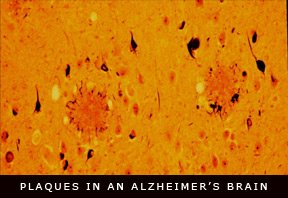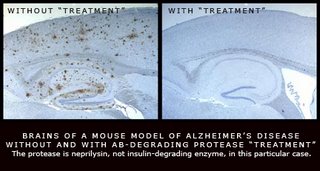Welcome to “From the Lab,” a series of posts written by myself (Malcolm Leissring) and Claes Wahlestedt, two Alzheimer’s researchers at Scripps Florida, and edited by Susan Shepard, a public high school teacher with a talent for making complicated topics easy to understand. In this series, we hope to explain in plain language, first, what scientists believe is the cause of Alzheimer’s disease, and second, what we are doing in the lab to develop treatments based on that understanding.
Lesson 1.
Q: What causes Alzheimer’s disease?
A: Too much “beta-amyloid.”
We all know that Alzheimer’s is a mind-robbing disease, what doctors call “dementia.” Symptoms typically start with relatively benign memory loss (“Where are my keys”), and worsen progressively until the victim cannot lay down new memories, which leads to confusion and sometimes psychosis.

The brain of an Alzheimer’s patient eventually shrinks, due to the loss of nerve cells that are responsible for all of our mental activities.
So what causes all this damage? Thanks to about 2 decades of progress, we now know. The culprit is a small, sticky piece of protein, called “beta-amyloid.” I know, I know—“beta-WHAT?” Why do scientists have to use these fancy terms? Why can’t they speak English?
Let’s try to break it down. The term “amyloid” actually means “starch-like.” The term is an accident of history, developed by scientists in the 1800s. As it turns out, amyloid actually had nothing to do with starch (the stuff you find in potatoes and pasta, or dry-cleaned shirts). However, it is important to remember that these pioneering scientists did not have all the wonderful tools and knowledge that we do today. Back in the 1800s, people who studied diseases used to take slices of tissue from deceased patients, and apply different colored dyes to them and look at them under a microscope. Back then “amyloid” referred to a special kind of “clump” they found in many different diseases. What made it special was that the clumps would glow bright green (like a fluorescent marker) when they treated the tissue with certain dyes.
These scientists found “amyloid” deposits in a lot of different diseases, and they were found to be formed by pieces of proteins, which were eventually given different names: “amyloid-A protein,” for example, was found in many different organs in patients suffering from a certain disease. The amyloid found in Alzheimer’s disease was restricted to the brain and was termed “amyloid-beta protein,” which has subsequently been shortened to “beta-amyloid,” or sometimes to the even shorter version, “A-beta.” Clumps of beta-amyloid make up the “plaques” that litter the brains of Alzheimer’s patients.
We will get into the nitty-gritty details later, but what we have learned over the past 20 years or so is that Alzheimer’s disease is caused by excessive accumulation of beta-amyloid, which likes to stick to itself and form plaques, which more or less clog the brain and interfere with it’s functioning.
For years, beta-amyloid was believed to be an abnormal protein, something present in Alzheimer’s victims, but not in normal people. This was true for some amyloid diseases, but turned out to be incorrect for Alzheimer’s disease. In fact, all of us produce beta-amyloid, and all of us, if we make it to ~40 years of age, get some small plaques in our brains.

The difference between Alzheimer’s disease and no Alzheimer’s disease is simply a reflection of the amount of beta-amyloid that accumulates.
Recently, we learned that beta-amyloid levels reflect the balance between their rate of production and their rate of clearance, or removal, from the body. My lab studies special enzymes that breakdown beta-amyloid, and we have shown in mouse models of Alzheimer’s that we can completely prevent the disease from forming if we increase the levels of these enzymes. This is a completely new idea, and may explain the majority of Alzheimer’s disease cases. At Scripps Florida, we are working very hard to turn this advance in our understanding into viable treatments for this devastating disorder.
More to come.....
--Malcolm

Dear Dr. Malcolm,
ReplyDeleteThank you for your wonderful post. This is the first time I've ever found anything on the Internet which FINALLY explained AD in an easy to understand manner!
Thank you for the work you do.
Regards,
Gordon
diagnosed with early onset AD
When my father was first diagnosed with Alzheimer's all anyone could tell me about his disease was that there was nothing we could do. You have helped so much by clearly explaining the "scientific" aspect of the disease and I want to thank you for making this effort. We will find a path from curse to cure.
ReplyDeleteThank you for reaching out to us "non-scientists".
Thank you for that explanation. It is very exciting to read that enzymes can play such an important role in the prevention of this disease. I am so grateful for the work you are doing. Thank you.
ReplyDelete